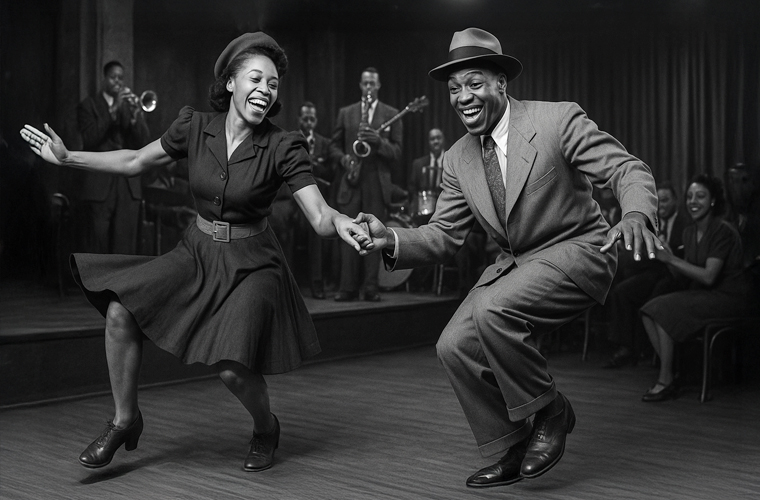Boogie-woogie emerged as a vibrant and energetic form of blues piano, characterized by its emphatic percussive quality that mimics the rhythmic pulse of everyday life. At its core, the style features the right hand delivering lively riffs—those syncopated, repeating phrases that weave intricate melodies and improvisational flourishes—while the left hand anchors the piece with a relentless ostinato bass, a hypnotic pattern of repeating eighth notes that drives the music forward like a freight train. This interplay creates an infectious groove, blending raw emotional depth from the blues tradition with a danceable, propulsive energy that invites listeners to tap their feet or sway along.
The roots of boogie-woogie can be traced back to the late 19th century, likely developing in the piney woods of East Texas among itinerant African American piano players who traveled to the lumber and turpentine camps, sharing their music in makeshift venues. These early practitioners drew inspiration from the rolling bass lines of guitar accompaniments in rural blues settings, adapting them to the piano’s broader sonic palette to evoke the motion of wagons or the sway of Southern life. By the dawn of the 20th century, the style had taken shape in the southwestern United States, earning nicknames like “fast Western-style” and “Western rolling blues” that reflected its regional swagger and tempo. Though the exact origin of the term “boogie-woogie” remains shrouded in oral history—possibly linked to West African linguistic echoes or slang for dancing—it crystallized around the 1920s, with Clarence “Pinetop” Smith often credited for popularizing it through his recordings.



As the Great Migration carried Black musicians northward, boogie-woogie found fertile ground in the bustling South Side of Chicago during the 1920s. There, it echoed through smoke-filled honky-tonks—rowdy, unlicensed bars pulsing with after-hours energy—and rent parties, where tenants hosted lively gatherings to cover their housing costs, transforming cramped apartments into impromptu concert halls. Pianists hammered out tunes on battered uprights, their rolling bass lines cutting through the chatter and clinking glasses, fostering a communal spirit that blended joy, resilience, and the blues’ inherent melancholy. Yet, despite this underground fervor, boogie-woogie simmered on the fringes of mainstream awareness until the late 1930s, when it burst into the national spotlight amid the swing era’s craze for rhythmic innovation.
The pinnacle of its fame arrived on December 23, 1938, at New York City’s Carnegie Hall, during John Hammond’s groundbreaking “From Spirituals to Swing” concert. This electrifying event showcased boogie-woogie as a cornerstone of American music, with luminaries like Albert Ammons, Pete Johnson, and Meade “Lux” Lewis delivering thunderous performances that captivated audiences and critics alike, bridging folk roots with urban sophistication. The concert not only immortalized the genre on records and radio but also influenced broader jazz and popular music, seeping into big band arrangements and even early rock ‘n’ roll rhythms.
No discussion of boogie-woogie would be complete without honoring its trailblazing architects, whose virtuosic playing and innovative spirit propelled it from obscurity to acclaim. Jimmy Yancey, a Chicago rent-party staple, brought a subtle, house-rent shuffle elegance to the style, his economical phrasing emphasizing groove over flash and inspiring generations with tracks like “Five O’Clock Blues.” Pinetop Smith, whose 1928 recording of “Pinetop’s Boogie Woogie” became the genre’s first major hit and arguably coined the phrase in his spoken intro, infused it with playful showmanship and infectious hooks. Albert Ammons thundered with orchestral power on his Steinway, collaborating seamlessly with drummers to amplify the piano’s percussive drive, as heard in classics like “Boogie Woogie Stomp.” Pete Johnson, a Kansas City transplant, matched Yancey’s intensity with barrelhouse flair, his collaborations with Big Joe Turner foreshadowing rhythm and blues. And Meade “Lux” Lewis, with his dazzling runs and dramatic builds—epitomized in the marathon “Honky Tonk Train Blues”—added a theatrical flair that made boogie-woogie feel like a solo spectacle.
Tragically, boogie-woogie’s meteoric rise proved fleeting. As World War II reshaped American culture in the 1940s—shifting tastes toward bebop jazz, crooners, and emerging rock influences—the style waned rapidly, its raw, piano-centric energy overshadowed by amplified ensembles and new sounds. By the 1950s, it had receded into niche revivals and European interpretations, though its indelible footprint lingers in the DNA of countless genres, from rockabilly to modern blues. Today, boogie-woogie endures as a testament to the ingenuity of African American musicians —a rhythmic blueprint that transformed hardship into high-spirited harmony.

